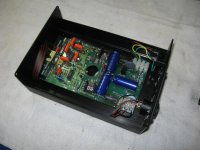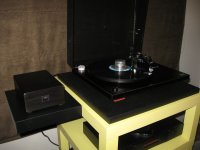Hi All
I moved to the US from the UK a few years ago since which time my turntable has been in a box and my vinyl sitting un-listened too.
Does anyone know if the power supply in the Rega will run on 110v rather than 240v in the UK? Also if it will not will it be best to replace the power supply unit in the turntable or could i use a transformer plugged into the mains? The latter worries me as i would imagine even a good one would cause some low level hum. I obviously dont want to risk causing any damage.
Best
AndyRoo
I moved to the US from the UK a few years ago since which time my turntable has been in a box and my vinyl sitting un-listened too.
Does anyone know if the power supply in the Rega will run on 110v rather than 240v in the UK? Also if it will not will it be best to replace the power supply unit in the turntable or could i use a transformer plugged into the mains? The latter worries me as i would imagine even a good one would cause some low level hum. I obviously dont want to risk causing any damage.
Best
AndyRoo
The standard in the US is 120 volts 60hz. The standard in Europe depends on where you are but mostly 240 volts 50 hz. If you buy a transformer, you can convert 120 volts to 240, however, whether or not your turntable operates properly will depend on the type of motor it has. If it has an hysteresis synchronous (clock) motor that is synchronized to the line frequency it will turn too fast. If it has an induction or DC servo motor it should be okay. Check with the manufacturer to be sure. In some cases, this can be corrected by changing the motor pully to a different size. The manufacturer should have these available since Rega exports to the US.
I was in the UK which is 240v but not sure on hz?
A
50Hz.
A couple of options, the easiest would be to find a 50Hz power source for your Rega. (See eBay) I suspect that the only other option would be to get a motor with the 60Hz pulley which I believe could be relatively expensive. Apparently there is an upgrade motor from Rega which is reputedly an improvement over the original motor fitted.
Last edited:
Find a good local audio store (or search the web) - you can order a replacement US-spec pulley. The motor will run fine on 120V-60Hz, although IIRC the inline resistor before the motor is a little high and thus the motor has issues with platter spin-up (just give the platter a initial push and it's okay).
I had to do the same for an old Planar-1 that was from the UK.
Good luck,
-bill
I had to do the same for an old Planar-1 that was from the UK.
Good luck,
-bill
Find a good local audio store (or search the web) - you can order a replacement US-spec pulley. The motor will run fine on 120V-60Hz, although IIRC the inline resistor before the motor is a little high and thus the motor has issues with platter spin-up (just give the platter a initial push and it's okay).
I had to do the same for an old Planar-1 that was from the UK.
Good luck,
-bill
In the case of a lot of Philips, Hurst, and Premotec motors that resistor (5K or more) should be removed for 120V operation. (Double check before doing this just in case you have a motor variant that needs a series resistor.)
Hi Bill
A few years after you responded I am finally wanting to make this mod. Let me know if you are still active as I have checked out the motor and it is a Premotec and so as you suggested it seems like I can just need to remove the resistor - and i just need to know how.
Andy
A few years after you responded I am finally wanting to make this mod. Let me know if you are still active as I have checked out the motor and it is a Premotec and so as you suggested it seems like I can just need to remove the resistor - and i just need to know how.
Andy
First off, buy a new pulley. I put a pulley on from TangoSpinner in Argentina. Gus is a good guy. I bought the full subplatter upgrade kit, pulley, belts, subplatter and bearing. This made a huge difference in the sound and I highly recommend it. It isn't that expensive either, and you need the pulley anyway.
The 50hz in the UK spins the synchronous AC motor at 250rpm. if you apply 60hz to the motor it will spin at 300rpm. The voltage doesn't matter, only the mains frequency. The resistor is unnecessary for the lower US voltage according to the data sheet. http://www.farnell.com/datasheets/526545.pdf
At 300rpm you need a different pulley size so that the belt moves the same distance per minute to maintain 33 1/3rpm of the platter.
Good luck with it.
The 50hz in the UK spins the synchronous AC motor at 250rpm. if you apply 60hz to the motor it will spin at 300rpm. The voltage doesn't matter, only the mains frequency. The resistor is unnecessary for the lower US voltage according to the data sheet. http://www.farnell.com/datasheets/526545.pdf
At 300rpm you need a different pulley size so that the belt moves the same distance per minute to maintain 33 1/3rpm of the platter.
Good luck with it.
Last edited:
Hi
This is really helpful. Two things:
1) Which of the upgrade kits do you recommend for the RP3?
2) Are you saying that i just need to effectively bypass the resistor and this will then operate with no other issues?
Thanks
A
This is really helpful. Two things:
1) Which of the upgrade kits do you recommend for the RP3?
2) Are you saying that i just need to effectively bypass the resistor and this will then operate with no other issues?
Thanks
A
I bought the Canaro kit for myself. This includes a dual 33 1/3 pulley and 2 belts, but then 45rpm is not possible. For me this didn't matter as I hadn't played a 45 on it in the 30 years I've had it. Of course, I then came into possession of a few 45s recently that I want to play. There is also a kit that has the 33/45 pulley on it and uses a single belt, but it is otherwise the same.
As for the resistor, that is what the data sheet says. For 110-117v AC input you don't need the resistor. My motor isn't the same one as the datasheet though, and you should check that yours is. Only the later P3s had that motor. Check the part number on the motor if you can. If it is the older one, I'd have to check my own to tell you what mine has. Let me know and I'll take a look.
As for the resistor, that is what the data sheet says. For 110-117v AC input you don't need the resistor. My motor isn't the same one as the datasheet though, and you should check that yours is. Only the later P3s had that motor. Check the part number on the motor if you can. If it is the older one, I'd have to check my own to tell you what mine has. Let me know and I'll take a look.
Last edited:
Another option....
Locate a Linn Valhalla power supply, put in a separate box, get a 50hz pulley (oh wait, you already have that).
I did this and the improvement was significant. The Rega motor is virtually the same as in the Linn. For an umbilical I used a std. 16/3 power cord which will fit in the stock power cord hole on the plinth with a little coaxing. For a connector I used a "SpeakOn".
If you ever go back across the pond you can easily swap the Valhalla to operate on 220v.
No more Rega "runs fast" issues and speed stability was markedly improved.
Just a thought.
Locate a Linn Valhalla power supply, put in a separate box, get a 50hz pulley (oh wait, you already have that).
I did this and the improvement was significant. The Rega motor is virtually the same as in the Linn. For an umbilical I used a std. 16/3 power cord which will fit in the stock power cord hole on the plinth with a little coaxing. For a connector I used a "SpeakOn".
If you ever go back across the pond you can easily swap the Valhalla to operate on 220v.
No more Rega "runs fast" issues and speed stability was markedly improved.
Just a thought.
Attachments
- Status
- Not open for further replies.
- Home
- Source & Line
- Analogue Source
- US Power for Rega Planar 3

